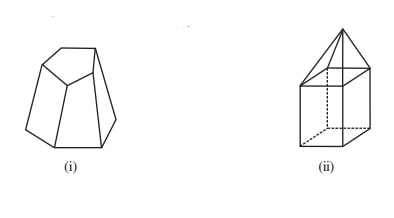Verify Euler’s formula for these solids.

Solution:
According to Euler’s formula, in any polyhedron, F + V - E = 2, where ‘F’ stands for the number of faces, ‘V’ stands for the number of vertices and ‘E’ stands for the number of edges.
(i) In the figure we can see that top and bottom faces are pentagons.
Number of faces, F = 7
Number of edges, E =15
Number of vertices, V =10
Let’s verify Euler’s formula,
F + V - E = 7 + 10 - 15
= 17 - 15 = 2
Thus, Euler's formula is verified.
(ii) In the figure we can see that its top is a square pyramid and the bottom is a square prism.
Number of faces, F = 9
Number of edges, E = 16
Number of vertices, V = 9
Let’s verify Euler’s formula,
F + V - E = 9 + 9 - 16
= 18 - 16 = 2
Thus, Euler's formula is verified.
☛ Check: NCERT Solutions for Class 8 Maths Chapter 10
Video Solution:
Verify Euler’s formula for these solids
Maths NCERT Solutions Class 8 Chapter 10 Exercise 10.3 Question 6
Summary:
Euler’s formula for the given solids is verified.
☛ Related Questions:
- Can a polyhedron have for its faces (i) 3 triangles? (ii) 4 triangles? (iii) a square and four triangles?
- Is it possible to have a polyhedron with any given number of faces? (Hint: Think of a pyramid).
- Which are prisms among the following?(i) How are prisms and cylinders alike? (ii) How are pyramids and cones alike?
- (i) How are prisms and cylinders alike? (ii) How are pyramids and cones alike?
visual curriculum
